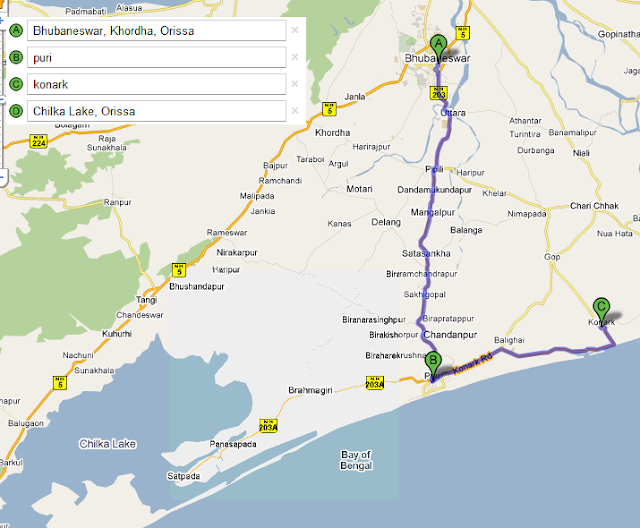Planning Bhubneshwar Jagannath Puri Tour : 4 days
The schedule:
Day 1:Local sightseeing in Bhubaneswar - cover Lingaraj, Rajarani and Mausima temples and Dhaulagiri-the Buddhist Stupa. If theres time you can visit Nandankanan(30km),the awesomely densely wooded zoo. Drive to Puri 60 km from Bhubaneswar.
Day 1:Local sightseeing in Bhubaneswar - cover Lingaraj, Rajarani and Mausima temples and Dhaulagiri-the Buddhist Stupa. If theres time you can visit Nandankanan(30km),the awesomely densely wooded zoo. Drive to Puri 60 km from Bhubaneswar.
Day 2: stay in one of the several beachside hotels. Visit the Jagannath temple, spend the evening on the beach .
Day3 : head to Konark (konark to puri is 35 Kms). You can finish the Sun temple in a couple of hours and drive back to Puri that night itself. Nothing much to do in Konark as the sea has too strong tides and you only need to spend an hour at the Sun Temple
Day 4:drive out to Satapada-the confluence of chilka lake and the sea.Its around 30 to 35 kms.
Parashurameshwara Temple is one of the best examples of the Orissa style of temple architecture. This temple followed very rigid parameters set by the ritualistic books. The temple has some exquisite carvings and sculpture.
Vaital Deul (800 ad) has a double-storied wagon roof, which in turn is an influence of the Buddhist cave architecture. The interior of the temple has the image of Chamunda (an incarnation of Goddess Kali).
Mukteshwar Temple(7th�8th century ad) is one of the most ornated temples in the Bhubaneswar. The intricate carvings of the deities testify the influence of Hindu, Buddha, and Jain style of architecture. The carvings on the roof are specially striking.
The Rajarani Temple (1100 ad), which derives its name from the stone known as the Rajarani, was built earlier in comparison to the impressive Lingaraja. Set amongst picturesque paddy fields, the relatively small Rajarani temple is noted for its fascinating female figures portrayed in a stunning variety of amorous poses and moods.
Brahmeswara Temple (1050 ad) is situated around a kilometer east of the main road. The temple stands in a courtyard flanked by four smaller temples.
Chilika Lake is a bounded lake with one outlet into the sea, so the tides are not high. There are gentle waves; the largest brackish water lake in Asia covering an area of over 1,100 sq. km.Kalijai Island, Honeymoon Island, Breakfast Island, Birds Island, Nalabana (Island of Reeds), Parikud Island, etc. are some of the important and interesting spots inside the lake. Millions of Migratory Birds, vast water Spread, inviting islands and of course the Irrawaddy Dolphins.
Sun Temple at Konark -- arriving as the sun was going down then being right there the next morning as the sun was coming up.The massive structure, now in ruins, sits in solitary splendour surrounded by drifting sand. Today it is located two kilometers from the sea, but originally the ocean came almost up to its base.
CHANDRA BHAGA
At about 3 kms from the Sun Temple at
Konark is the Chandrabhaga beach. The strong currents do not make it either safe or easy for swimming. But the picturesque view of the sunrise and sunset at this place is enchanting.
According to a myth, the Sun God is believed to have sought a beautiful sea-maiden named Chandrabhaga. After chasing her up to this point, she is said to have disappeared into the sea.
The Temple of Lord Jagannath built during the 12th century A.D. by Chodaganga Deva dominates the landscape for kilometers around. Being the tallest temple (65 metres) in Orissa, it is one of the most magnificent pieces of monuments of India. In front of the main gate stands a 16 sided monolithic pillar (11 metres high), called Aruna Stambha which formally stood in front of the Sun Temple and was brought to Puri during the 18th century A.D. Some of the other important temples are Gundicha, Lokanath, Sunaragauranga, Daria Mahabir and Tota Gopinatt. There are also a number of holy tanks like Narendra, Markandeya, Sweta Ganga and Indradyumna. There are many Monasteries locally known as Mathas also of touristic interest.



Comments